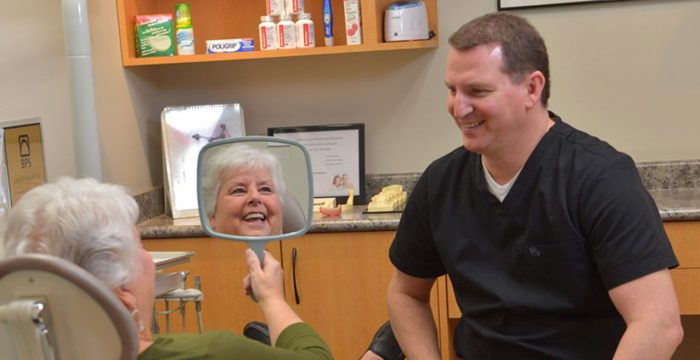Your First Dentures

When it comes time to get your first dentures made it can be quite an emotional experience. If you follow the advice of your denturist and maintain your dentures properly you will join a community of satisfied denture wearers (and no one even needs to know). Educating yourself and understanding the choices you have will help you through the transition.
- Immediate dentures
- Post Immediate Dentures
- Transitional Dentures
Immediate Dentures
During the immediate denture procedure, an impression of your mouth is taken prior to extractions. Then your denture is fabricated for insertion by your dentist on the day of your extractions. Sounds simple but immediate dentures have their limits. Since the impression of your gums (with your natural teeth) and the bite measurement is taken before extractions there is no way to guarantee that they will be a good fit. The tissue and bone level in your mouth will change after extractions but the denture that was made prior to the extractions will not. Also, this option does not allow you to try in the denture to make sure you like the aesthetics (the look) of the denture.
Some patients choose this method because they cannot take time off work while they get their dentures made or they may have a medical condition that requires them to have an immediate denture placed at the time of extractions. If this is the route you decide to take, you may need to have another denture made in the future if your immediate denture does not fit or function well during the healing period.
During the first 24 hours after tooth extractions and immediate denture placement, it is critical that that you do not remove the denture until you see your Denturist. Premature removal of the immediate denture could make its re-insertion difficult because of the swelling of the oral tissues. A soft food and liquid diet is also encouraged for the first 24 hours. Please follow all dentist recommended care for antibiotics and pain management.
Post-Immediate Dentures
Post-immediate dentures are constructed after your teeth are extracted. Since extractions will affect the tissues in your mouth and the jaw bone, the longer you can wait for impressions and the bite measurement the better. We can usually take the first impressions for post immediate dentures approximately 10 days after extractions if everything looks good and there are no complications. Post-immediate dentures usually take 2 1/2 to 3 weeks to complete.
Post-immediate dentures allow the Denturist to construct your dentures with more care, accuracy and attention to detail. However, the most important advantage and the reason most people choose post-immediate is because they can try in their new dentures and make changes to the aesthetics (the look) before finished in denture acrylic. The degree of satisfaction with this method is increased two fold as the fit, function and aesthetics can be controlled.
Transitional Dentures
A third option exists. You can choose an immediate denture so you don’t have to go without teeth and then later you can transition to your final permanent denture. You can do this quickly or a few months later. This method offers the best of both worlds but it does cost more.
Regular Maintenance, Temporary Liners and Relines
Whether or not you have immediate or post-immediate dentures, regular maintenance for the first year is critical. It is necessary for your Denturist to make adjustments to your dentures, add temporary liners to refit your dentures while your gums heal and resorb. At approximately twelve months, the Denturist will remove the temporary liner and replace it with a permanent reline.
Denture Maintenance Schedule
After your first reline, it is recommended that you Reline your dentures every 2 to 3 years and replace your dentures every 5 to 7 years, depending on the amount of wear on the teeth and shrinkage of your gums.
What is Bone Loss?
When an adult tooth is removed and not replaced, jawbone deterioration may occur. Natural teeth are embedded in the jawbone and stimulate the jawbone through activities such as chewing and biting. When teeth are missing, the alveolar bone, or the portion of the jawbone that anchors the teeth in the mouth, no longer receives the necessary stimulation, and begins to break down, or resorb. The body no longer uses or “needs” the jawbone, so it deteriorates and goes away. The rate the bone deteriorates, as well as the amount of bone loss that occurs, varies greatly among individuals. However, most loss occurs within the first twelve months following the extraction, and continues throughout life.

Dentures do not provide any direct stimulation to the underlying alveolar bone. Over time, the lack of stimulation causes the bone to resorb and deteriorate. Conventional dentures rely on the bone to hold them in place and over time people often experience loosening of their dentures and problems eating and speaking. Eventually, bone loss may become so severe that dentures cannot be held in place even with strong adhesives. Dental implants will then be necessary to preserve the remaining bone and to hold the denture in place.
Proper denture care, repair, and refitting are essential to maintaining oral health and preserving bone.
Dentures on Implants
If you are considering extractions of your upper and/or lower teeth, placing implants at the time of extractions should be a consideration. We can help with your treatment and refer you to an implant specialist that will assess whether or not you are a candidate for placing implants at the time of extractions. If costs are a concern, financing is available for your dental treatment.
Financing Options
Dental treatment can be an expensive but necessary endeavour especially if you don’t have dental insurance. Some treatments cost less than others but it’s best that you do your homework to find out which dental treatment is best for you and your health before making a decision.
